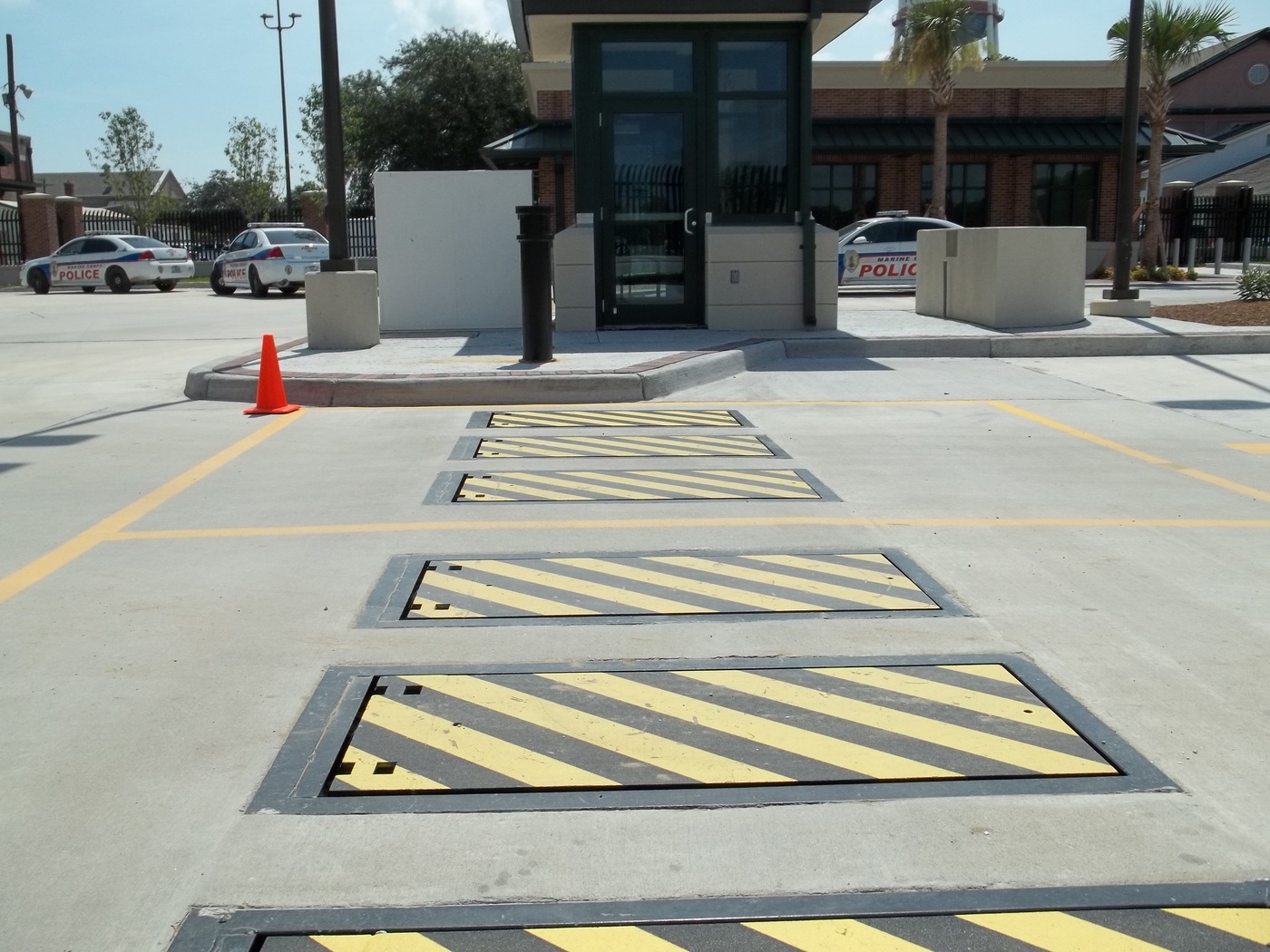Wedge Barriers for Dummies
All about Wedge Barriers
Table of ContentsWedge Barriers Things To Know Before You Get ThisSome Ideas on Wedge Barriers You Need To Know


18 might be done faster, easily, and expense effectively. FIG. In certain embodiments, the support 30 may be a steel frame consisting of plates, light beams(e. g., I-beams ), and/or various other structures that are protected within the structure 14, which may be concrete. At the surface 12, an upper side 28 of the support 30 may be at least partially exposed
, thus making it possible for the attachment of the obstacle 10 to the anchor 30. g., threaded openings)in several beams or plates of the support 30 might be revealed to the surface area 12. In this way, screws 32 or other mechanical fasteners might be utilized to secure the barrier 10 to the support 30. As the barrier 10 is mounted to the surface area 12 of the foundation 14, collection of particles and other product underneath the obstacle might be lowered, and parts of the bather 10 may not be exposed to below quality settings. As shown by recommendation numeral 52, the training mechanism 50 consists of components got rid of underneath the wedge plate 16. The components 52 below the wedge plate 16 might consist of an electromechanical actuator, a web cam, one or even more camera surfaces, and so forth. Furthermore, the lifting mechanism 50 includes a springtime setting up 54
The springtime rod 58 is paired to a camera(e. g., cam 80 revealed in FIG. 4) of the lifting system 50. The springtimes 60 disposed about the spring rod 58 are kept in compression by springtime sustains 62, including a dealt with springtime support 64. That is, the click for source fixed springtime support 64 is taken care of about the structure 14 and the remainder of the bather 10.
7 Easy Facts About Wedge Barriers Described
The continuing to be pressure used to
the cam webcam deploy release wedge plate 16 may might provided offered an electromechanical actuator 84 or other actuator. The spring setting up 54 and the actuator 84(e. Wedge Barriers. g., electromechanical actuator)may operate together to equate the camera and raise the wedge plate 16.
As mentioned over, the spring assembly 54 exerts a consistent pressure on the webcam, while the electromechanical actuator may be managed to exert a variable force on the camera, consequently allowing the lifting and decreasing( i. e., deploying and withdrawing )of the wedge plate 16. In particular personifications, the constant pressure used by the spring setting up 54 might be flexible. g., electromechanical actuator) is impaired. As will certainly be appreciated, the springtime setting up 54 may be covered and safeguarded from debris or various other elements by a cover plate(e. g., cover plate 68 shown in FIG. 4) that might be considerably flush with the raised surface area 38 of the structure 14. As pointed out above, in the released position, the wedge plate 16 serves to block accessibility or traveling past the barrier 10. The barrier 10(e. g., the wedge plate 16 )may obstruct pedestrians or cars from accessing a property or pathway. As discussed above, the barrier 10 is attached to the support 30 safeguarded within the foundation 14,

front brackets 71. Therefore, the affiliation settings up 72 might pivot and turn to enable the collapse and extension of the link settings up 72 during retraction and implementation of the bather 10. The affiliation assemblies 72 cause movement of the wedge plate 16 to be limited. If a car is traveling towards the deployed wedge plate 16(e. For example, in one condition, the safety legs 86 might be expanded duringmaintenance of the barrier 10. When the safety and security legs 86 are released, the safety and security legs 86 support the weight of the wedge plate 16 versus the surface area 12. Therefore, the lifting device 50 might be shut down, serviced, gotten rid of, changed, etc. FIG. 5 is partial perspective sight of a personification of Recommended Reading the surface-mounted wedge-style obstacle 10, showing the camera 80 and the webcam surface areas 82 of the training device 50. Specifically, 2 camera surfaces 82, which are described as lower web cam surface areas 83, are placed below the webcam 80. The reduced webcam surface areas 83 may be repaired to the surface area 12 (e. For instance, the reduced webcam surface areas 83 and the installing plate 85 may form a solitary piece that is secured to the anchor 30 by bolts or other mechanical bolts. In addition, two cam surfaces 82, which are referred to as top cam surfaces 87, are placed over the cam 80 and paired to (e. In various other embodiments, intervening layers or plates might be positioned in between the surface area 12 and the lower cam surfaces 83 and/or the wedge plate 16 and the upper cam surfaces 87 As mentioned over, the webcam
80 translates along the cam surface areas 82 when the wedge plate 16 is raised from the pulled back position to the released placement. In addition, as discussed above, the spring assembly 54 (see FIG. 3 )might give a force acting on the cam 80 in the direction 102 by means of spring rod 58, which may lower the force the electromechanical actuator 84 is needed to relate to the webcam 80 in order to activate and lift the wedge plate 16. 1 )to the released setting(see FIG. 4). As shown, the web cam 80 consists of track wheels 104(e. g., rollers), which contact and convert along the cam surface areas 82 throughout procedure.